What Are Network Attached Storage (NAS) Devices?

Network attached storage (NAS) devices are data storage devices connected to a Local Area Network (LAN), primarily used for file sharing within offices or factories and for tasks like PC data backup.
NAS devices are essentially specialized computers designed for file management, equipped with high-capacity hard disk drives. With the increasing use of large video data files captured on smartphones or digital cameras, NAS has also become popular for home network storage solutions. While server computers and cloud services are other methods for file sharing and data storage, NAS offers a cost-effective solution with large capacity, high-speed, and easy file sharing and data backup.
Uses of NAS Devices
NAS devices are versatile, serving as storage locations for shared files within a company, accommodating various file types from Word documents to JPEG images. They are particularly suitable for storing large video files in business settings. NAS devices are also used for regular backups of individual PCs, though high network traffic can impact performance if proper network segmentation isn’t implemented.
For personal use, NAS devices are increasingly common for storing large video data at home, thanks to affordable models designed for home use.
Principles of NAS Devices
NAS devices are dedicated computers that manage file storage and can save files sent from other PCs and transmit them upon request. These devices typically use Intel Core or Celeron processors, providing high reliability while not requiring the high performance of advanced CPUs. Consumer-grade NAS products often integrate a single Hard Disk Drive (HDD), while business-grade NAS allows multiple disk bays, enabling RAID configurations for data safety.
Some NAS products use solid state drives (SSD) for faster data handling. NAS connects to a router via a cable on the LAN, allowing access to files and folders from PCs and smartphones on the same network. File management software included with NAS can set access permissions for individual folders and files.
1. NAS Connection
NAS connects to a router via a LAN cable, allowing access to files within NAS-managed storage from devices on the same LAN. File management software sets access permissions for folders and files on NAS.
2. Roles of NAS
NAS facilitates high-speed information and data exchange within a network, though actual speed is limited by router capacity and line speed. Some NAS models support external access, enabling remote work environments.
NAS focuses on file sharing and individual data backup within departments or companies, offering efficient, cost-effective data exchange, sharing, and storage.
How to Choose NAS
When selecting NAS, consider factors like the number of PCs, required data capacity, and basic usage needs. Starting with a basic system and scaling up as needed can ensure a smooth transition.